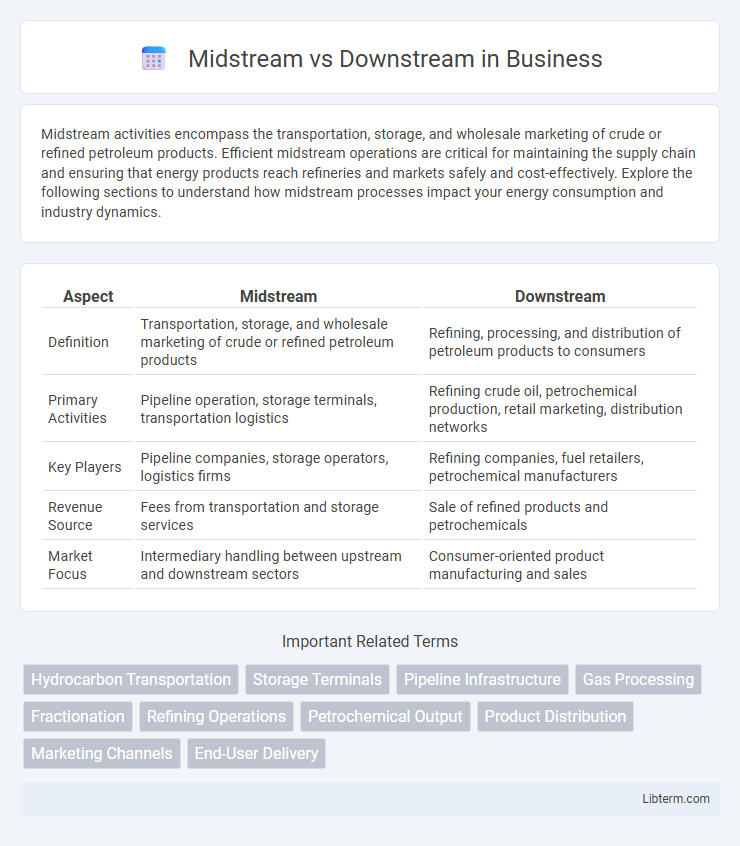Midstream activities encompass the transportation, storage, and wholesale marketing of crude or refined petroleum products. Efficient midstream operations are critical for maintaining the supply chain and ensuring that energy products reach refineries and markets safely and cost-effectively. Explore the following sections to understand how midstream processes impact your energy consumption and industry dynamics.
Table of Comparison
| Aspect | Midstream | Downstream |
|---|---|---|
| Definition | Transportation, storage, and wholesale marketing of crude or refined petroleum products | Refining, processing, and distribution of petroleum products to consumers |
| Primary Activities | Pipeline operation, storage terminals, transportation logistics | Refining crude oil, petrochemical production, retail marketing, distribution networks |
| Key Players | Pipeline companies, storage operators, logistics firms | Refining companies, fuel retailers, petrochemical manufacturers |
| Revenue Source | Fees from transportation and storage services | Sale of refined products and petrochemicals |
| Market Focus | Intermediary handling between upstream and downstream sectors | Consumer-oriented product manufacturing and sales |
Understanding the Oil & Gas Supply Chain
Midstream operations in the oil and gas supply chain primarily involve the transportation, storage, and wholesale marketing of crude oil and natural gas, utilizing pipelines, tankers, and storage facilities. Downstream activities focus on refining crude oil into finished products such as gasoline, diesel, jet fuel, and petrochemicals, along with distribution and retail through gas stations and marketing companies. Understanding the distinction between midstream and downstream sectors is crucial for optimizing logistics, ensuring regulatory compliance, and maximizing value in the energy industry.
What is Midstream?
Midstream refers to the segment of the oil and gas industry involved in the transportation, storage, and wholesale marketing of crude oil, natural gas, and refined products. This sector includes pipelines, tanker ships, storage facilities, and processing plants that ensure the efficient movement of hydrocarbons from upstream extraction sites to downstream refineries. Midstream operations are critical for maintaining supply chain stability and optimizing delivery logistics in the energy market.
What is Downstream?
Downstream refers to the refining, distribution, and marketing of petroleum products after crude oil extraction. It involves processes such as refining crude oil into gasoline, diesel, and other fuels, as well as transporting these products to retailers and end consumers. The downstream sector plays a crucial role in delivering finished products to industries, businesses, and households, ensuring energy availability and market supply.
Key Differences Between Midstream and Downstream
Midstream operations primarily involve the transportation, storage, and wholesale marketing of crude or refined petroleum products, using pipelines, tankers, and storage facilities. Downstream activities focus on refining crude oil into consumer-ready products such as gasoline, diesel, and petrochemicals, followed by distribution and retail sales. The key difference lies in Midstream's role in moving raw materials and intermediates, whereas Downstream centers on product refinement and delivery to end consumers.
Core Activities in Midstream Operations
Midstream operations primarily focus on the transportation, storage, and wholesale marketing of crude oil, natural gas, and refined products. Core activities include pipeline transportation, gathering systems, and storage facilities that ensure efficient movement from production sites to refineries or distribution points. These operations facilitate the seamless flow of hydrocarbons, bridging upstream extraction and downstream refining processes.
Core Activities in Downstream Operations
Downstream operations primarily focus on refining crude oil into finished products such as gasoline, diesel, jet fuel, and petrochemicals. Core activities include refining processes, distribution, marketing, and retailing of petroleum products to end consumers. These operations ensure product quality control, storage management, and supply chain logistics to meet market demand efficiently.
Revenue Streams: Midstream vs Downstream
Midstream revenue primarily derives from transportation tariffs, storage fees, and processing services associated with pipelines, terminals, and natural gas processing plants. Downstream revenue is largely generated from refining crude oil into finished products such as gasoline, diesel, and petrochemicals, alongside revenue from retail sales and distribution networks. The midstream sector typically relies on stable, fee-based income, while downstream revenues are more sensitive to product demand, refining margins, and fluctuating commodity prices.
Challenges Facing Midstream and Downstream Sectors
Midstream and downstream sectors face distinct challenges, with midstream companies grappling with infrastructure aging, regulatory compliance, and pipeline safety concerns that impact transportation efficiency and environmental risks. Downstream operations confront market volatility, stringent environmental regulations, and the need for digital transformation to optimize refining processes and meet evolving consumer demand for cleaner fuels. Both sectors require strategic investment and innovation to ensure resilience amid fluctuating energy markets and sustainability pressures.
Future Trends in Midstream and Downstream Industries
Future trends in the midstream industry emphasize increased adoption of smart pipeline technologies and advanced leak detection systems to enhance operational efficiency and safety. Downstream sectors are witnessing significant growth in biofuel production, refining automation, and digital twin technologies to optimize processing and reduce environmental impact. Both industries are accelerating investments in carbon capture and storage (CCS) solutions to meet global decarbonization targets and regulatory compliance.
Choosing a Career: Midstream vs Downstream
Choosing a career in the energy sector requires understanding the distinct roles of midstream and downstream segments; midstream focuses on the transportation, storage, and wholesale marketing of crude or refined petroleum products, offering opportunities in pipeline operations, logistics, and infrastructure management. Downstream careers emphasize refining, processing, distribution, and retail, involving technical roles in refining processes, quality control, and sales. Professionals prioritizing operational logistics and infrastructure typically prefer midstream, while those interested in product development and consumer markets lean toward downstream.
Midstream Infographic

 libterm.com
libterm.com